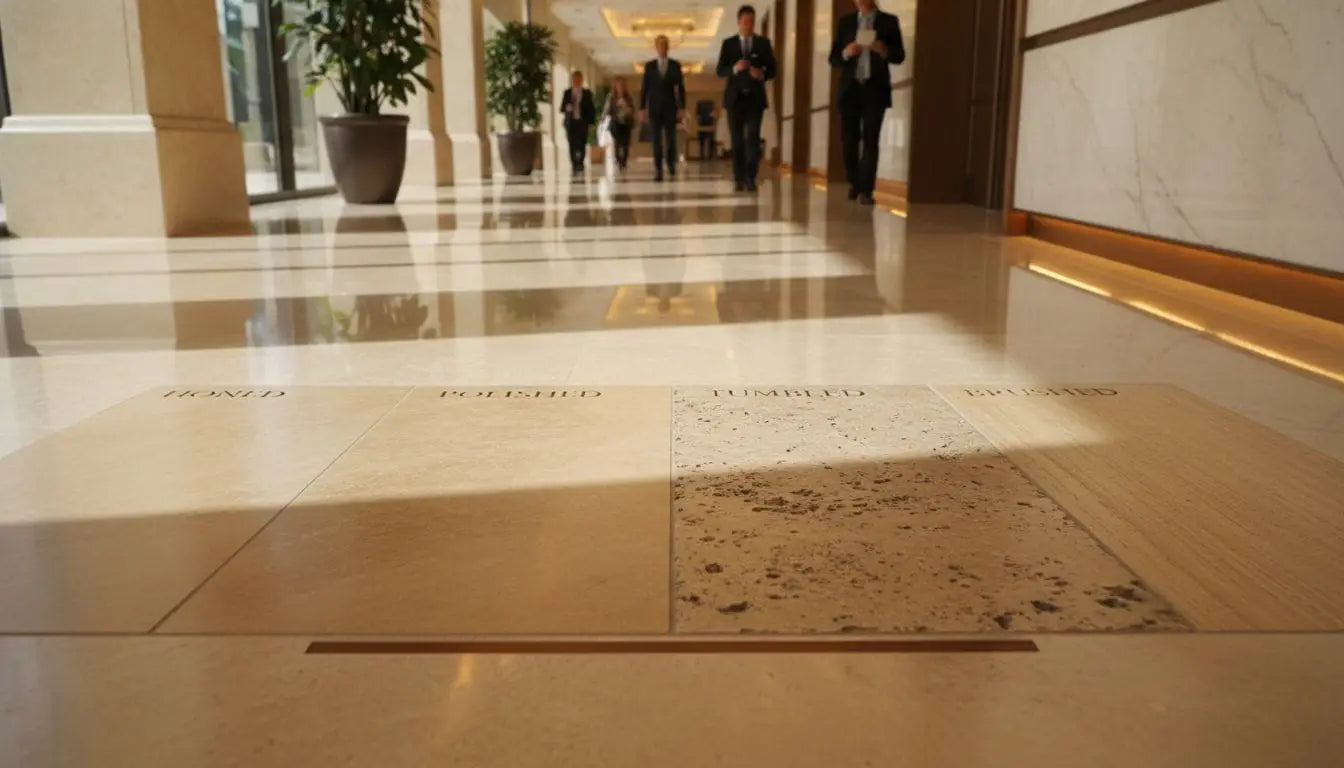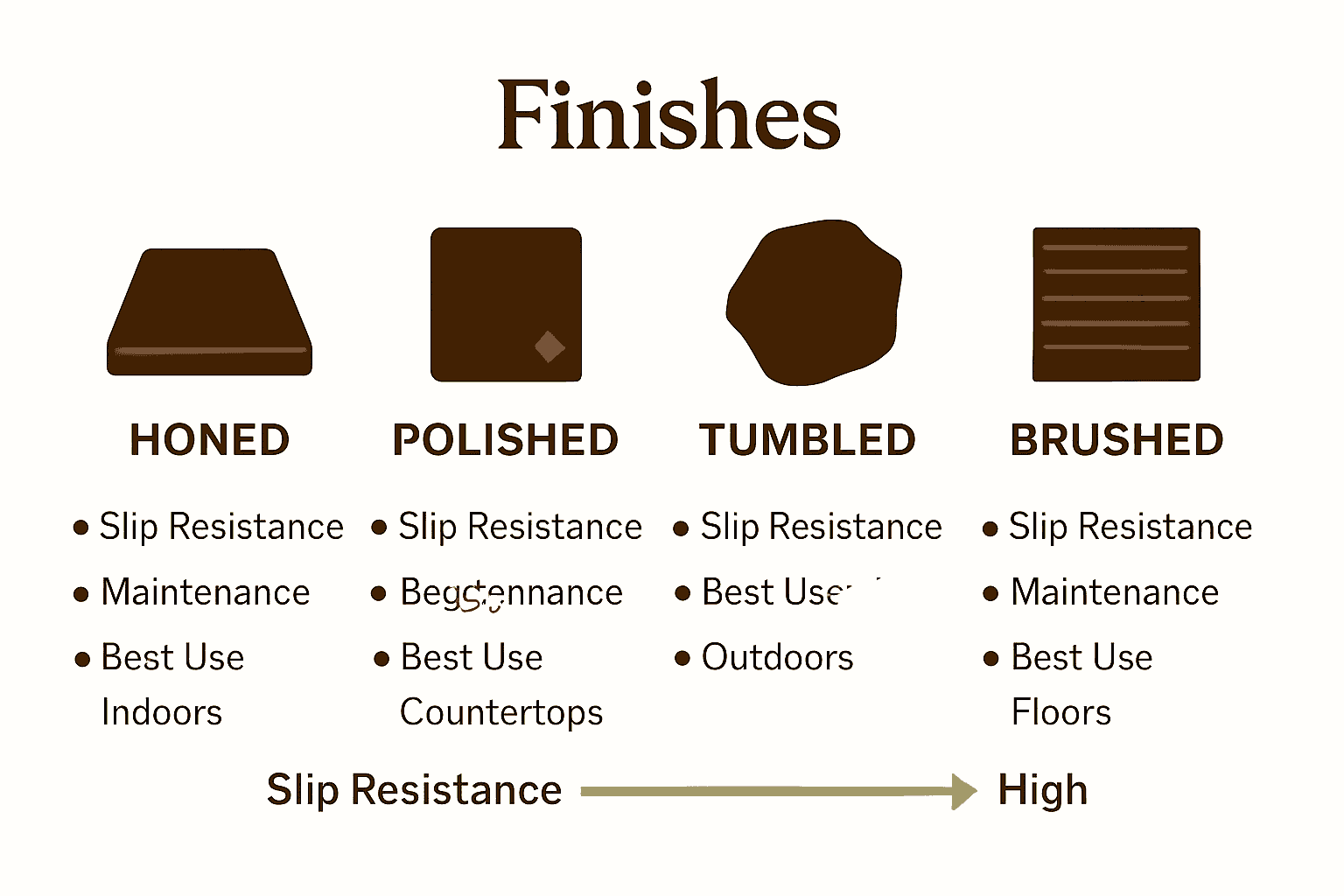Travertine Tile Finishes: Complete Guide for 2025

Did you know that over 60 percent of luxury home designers choose travertine for its adaptable surface finishes? The way travertine tile is finished not only shapes its look but also affects how safe and practical it is for kitchens, bathrooms, patios, and more. Understanding the differences between honed, polished, tumbled, and brushed finishes can help you create spaces that are beautiful, functional, and tailored to your lifestyle.
Table of Contents
- What Are Travertine Tile Finishes?
- Different Types of Travertine Finishes Explained
- Key Characteristics of Each Finish Type
- Best Uses for Different Travertine Finishes
- Comparing Travertine Finishes to Alternatives
- Installation, Care, and Common Mistakes
Key Takeaways
| Point | Details |
|---|---|
| Diverse Finishes | Travertine tiles offer various finishes—honed, polished, tumbled, and brushed—each providing unique aesthetics and performance characteristics. |
| Functional Applications | Each finish is suitable for specific environments, with honed ideal for high-traffic areas and polished suited for decorative installations. |
| Maintenance Considerations | Travertine requires specialized care including regular sealing and careful cleaning to maintain its beauty and longevity. |
| Professional Installation | Proper installation by a qualified contractor is crucial to ensure durability and visual appeal, minimizing common mistakes during the process. |
What Are Travertine Tile Finishes?
Travertine tile finishes represent the surface treatments applied to natural stone tiles that transform their visual appearance, texture, and functional characteristics. According to the Natural Stone Institute, these finishes are critical in determining how travertine will look and perform in residential and commercial spaces.
At its core, travertine tile finishes modify the stone’s surface through specialized techniques that enhance or alter its natural texture. As explained by the National Kitchen and Bath Association, different finishes like honed, polished, and tumbled create distinct visual and tactile qualities that dramatically change the stone’s aesthetic potential.
The primary travertine tile finishes include:
- Honed Finish: A smooth, matte surface with minimal sheen
- Polished Finish: A glossy, reflective surface that highlights the stone’s natural patterns
- Tumbled Finish: A rustic, aged appearance with rounded edges and a weathered texture
- Brushed Finish: A slightly textured surface that maintains the stone’s natural character
Each finish offers unique advantages for different design contexts, allowing designers and homeowners to select a style that perfectly complements their architectural vision. Discover our comprehensive guide to travertine styles to explore how these finishes can transform your space.
Here’s a comparison of the main travertine finishes and their characteristics:

| Finish Type | Surface Appearance | Slip Resistance | Ideal Applications |
|---|---|---|---|
| Honed | Smooth, matte | Good | Kitchens Bathrooms Hallways |
| Polished | Glossy, reflective | Low | Accent walls Fireplaces Reception areas |
| Tumbled | Rustic, aged, textured | Excellent | Patios Pool decks Garden paths |
| Brushed | Subtly textured, natural | Moderate | Floors Walls Entryways |
At Surfaces Galore, we understand that selecting the right travertine tile finish is more than a design choice—it’s about creating spaces that reflect your unique aesthetic and functional requirements. Our curated collection of travertine tiles offers an array of finishes to suit every design vision.
Different Types of Travertine Finishes Explained
Travertine tile finishes represent more than aesthetic choices—they fundamentally transform how natural stone performs and appears in interior and exterior spaces. According to the Natural Stone Institute, common travertine finishes include honed, polished, and tumbled varieties, each offering unique visual and functional characteristics.
Honed Finish: This popular finish creates a smooth, consistent surface with minimal reflectivity. Characterized by its matte appearance, honed travertine provides a soft, understated elegance that works beautifully in contemporary and traditional settings. Learn more about honed tile benefits in our comprehensive guide.
The primary travertine finishes break down into distinct categories:
Polished Finish
A glossy, high-shine surface that dramatically highlights the stone’s natural veining and color variations. Polished travertine reflects light brilliantly, creating a luxurious and sophisticated atmosphere. However, this finish can be more slippery and may require more maintenance.
Tumbled Finish
Embodying rustic charm, tumbled travertine features softened edges and a weathered texture that suggests age and character. As the National Kitchen and Bath Association explains, this finish delivers a textured, aged look perfect for creating warmth in Mediterranean or farmhouse-inspired designs.
Brushed Finish
Offers a subtly textured surface that sits between honed and tumbled styles. Brushed travertine maintains the stone’s natural variations while providing a gentle, tactile quality that adds depth and interest to floors and walls.
Pro Tip: When selecting a travertine finish, consider both aesthetic preferences and practical requirements. Some finishes perform better in high-traffic areas or moisture-prone environments like bathrooms and kitchens.
At Surfaces Galore, we understand that choosing the right travertine finish is a nuanced decision. Our expert guide to marble and travertine differences can help you make an informed choice that perfectly matches your design vision.
Key Characteristics of Each Finish Type
Understanding the nuanced characteristics of travertine tile finishes is crucial for making informed design decisions. According to the Natural Stone Institute, each finish type offers unique attributes that dramatically impact both aesthetic appeal and functional performance in residential and commercial spaces.
Honed Finish Characteristics
Honed travertine presents a smooth, matte surface with minimal reflectivity. This finish is characterized by:
- Uniform, consistent texture
- Reduced light reflection
- Enhanced slip resistance
- Ideal for high-traffic areas
- Subtle, understated elegance
Polished Finish Characteristics
A polished finish transforms travertine into a glossy, reflective surface that dramatically showcases the stone’s natural color variations and intricate patterns. While stunning, this finish requires more careful consideration. As the National Kitchen and Bath Association explains, polished travertine can be more slippery and demands additional maintenance.
Tumbled Finish Characteristics
Tumbled travertine embodies rustic charm with its weathered, aged appearance. This finish features:
- Softened, rounded edges
- Textured, uneven surface
- Enhanced slip resistance
- Vintage and Mediterranean-inspired aesthetic
- Ability to hide minor imperfections
Comparing Performance and Aesthetics
When selecting a travertine finish, consider these critical factors:

- Slip Resistance: Honed and tumbled finishes offer better traction
- Maintenance: Polished finishes typically require more frequent care
- Visual Impact: Each finish creates a distinct design statement
Explore our in-depth guide comparing marble finishes to further understand how surface treatments transform natural stone’s appearance and performance. At Surfaces Galore, we’re committed to helping you make the most informed design choices for your space.
Best Uses for Different Travertine Finishes
Selecting the right travertine finish requires understanding how each variant performs in different environments. According to the Natural Stone Institute, each finish type has specific ideal applications that maximize both aesthetic appeal and functional performance.
Honed Travertine: Versatile Performance Zones
Honed travertine excels in high-traffic areas where slip resistance and durability are paramount. Recommended applications include:
- Kitchen flooring
- Bathroom floors and walls
- Commercial entryways
- Residential hallways
- Outdoor walkways with moderate foot traffic
Polished Travertine: Decorative Elegance Zones
Polished travertine transforms spaces with its luxurious, reflective surface. As the National Kitchen and Bath Association suggests, this finish is ideal for:
- Formal living room accent walls
- Elegant bathroom vanity surrounds
- Decorative fireplace facades
- Upscale hotel lobby installations
- Sophisticated reception areas
Tumbled Travertine: Rustic and Outdoor Spaces
Tumbled travertine’s textured, aged appearance makes it perfect for creating warm, inviting environments. Optimal uses include:
- Outdoor patio flooring
- Pool deck surfacing
- Rustic garden pathways
- Mediterranean-style exterior walls
- Landscape design elements
Discover how silver travertine can elevate modern design spaces and explore innovative ways to incorporate these stunning finishes into your next project.
At Surfaces Galore, we understand that choosing the right travertine finish is about creating spaces that tell your unique design story. Our experts are ready to help you navigate these nuanced selections and transform your vision into reality.
Comparing Travertine Finishes to Alternatives
Navigating the world of natural stone tiles requires understanding how different materials and finishes compare in performance and aesthetic appeal. According to the National Kitchen and Bath Association, travertine finishes offer unique characteristics that distinguish them from alternative tile options.
Natural Stone vs Manufactured Alternatives
Travertine stands out from manufactured tiles through its inherent qualities:
- Unique, non-repeating natural patterns
- Organic color variations
- Enhanced thermal properties
- More substantial feel and weight
- Higher perceived luxury and value
Performance Comparison
When comparing travertine to ceramic or porcelain alternatives, critical differences emerge. As the Natural Stone Institute highlights, travertine provides:
- Superior natural slip resistance
- Better temperature regulation
- More distinctive aesthetic character
- Potential for long-term value appreciation
Maintenance and Longevity Considerations
Travertine requires more specialized care compared to manufactured tiles. While ceramic and porcelain offer simpler maintenance, travertine demands:
- Regular sealing
- Careful cleaning protocols
- Protection from acidic substances
- Professional restoration capabilities
Explore the enduring beauty of travertine flooring and discover why discerning designers continue to choose this timeless natural stone.
At Surfaces Galore, we believe in empowering our clients with comprehensive knowledge. Our experts can help you navigate the nuanced world of natural stone selection, ensuring your design vision becomes a stunning reality.
Installation, Care, and Common Mistakes
Travertine tile installation is an intricate process that demands precision and expertise. According to the Natural Stone Institute, proper installation involves critical steps that protect the stone’s long-term performance and aesthetic integrity.
Professional Installation Fundamentals
Travertine installation requires specialized techniques:
- Professional substrate preparation
- Precise moisture barrier application
- Specialized adhesive selection
- Careful tile alignment
- Minimal grout line implementation
Critical Sealing and Maintenance Protocols
As the National Kitchen and Bath Association recommends, travertine maintenance involves strategic care approaches:
- Immediate sealing after installation
- Annual resealing schedule
- Using pH-neutral cleaning solutions
- Avoiding abrasive cleaning tools
- Prompt stain treatment
Common Installation Mistakes to Avoid
Professional installers recognize several critical pitfalls:
- Inadequate substrate leveling
- Improper moisture barrier installation
- Using incorrect adhesive types
- Neglecting expansion joint requirements
- Failing to properly seal the stone
Understanding tile dimensions can dramatically improve your installation success, ensuring your travertine tiles look stunning for years.
At Surfaces Galore, our experts are committed to guiding you through every step of your travertine tile journey, transforming potential challenges into beautiful, lasting installations.
Elevate Your Space with the Perfect Travertine Tile Finish
Choosing the right travertine finish can feel overwhelming with so many options like honed, polished, or tumbled each offering unique textures and uses. Whether you need durability for high-traffic areas or a polished look for elegance, the key challenge is finding authentic, premium-quality natural stone that perfectly matches your design vision and stands the test of time. At Surfaces Galore, we understand these struggles and are dedicated to helping you select the ideal finish that balances beauty with practicality.

Discover our extensive collection of natural travertine tiles available in an array of finishes designed to inspire creativity and fulfill your exact project needs. Visit Surfaces Galore to experience authentic stone that combines style, durability, and affordability. Explore how our premium travertine solutions can transform your home or commercial space today. Don’t wait to create timeless elegance with natural stone tailored just for you.
Frequently Asked Questions
What are the different types of travertine tile finishes?
The primary types of travertine tile finishes include honed, polished, tumbled, and brushed. Each finish alters the stone’s appearance and texture, offering a variety of aesthetic and functional benefits.
How do I choose the right travertine tile finish for my space?
Consider both aesthetic preferences and practical needs. For high-traffic areas, honed or tumbled finishes may be preferable due to their slip resistance, while polished finishes suit decorative applications where elegance is prioritized.
What maintenance do travertine tiles require after installation?
Travertine tiles should be sealed immediately after installation and require regular resealing, typically annually. It’s important to use pH-neutral cleaning solutions and avoid abrasive tools to maintain their appearance and durability.
Why should I choose travertine tile over ceramic or porcelain options?
Travertine offers unique benefits, including distinct natural patterns, superior slip resistance, and better temperature regulation. While it requires more specialized care compared to manufactured tiles, its luxurious appearance and longevity can provide lasting value.

Leave a comment